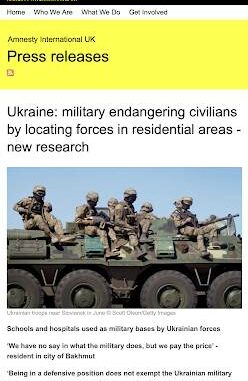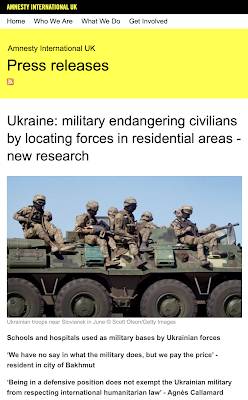
Ukraine – War Crimes and Its Civilian Population
While the Western media’s narrative on Ukraine has strictly followed the “if anything bad happens to civilians in Ukraine (including both Donetsk and Luhansk), the Russians are to blame” mantra, a recent press release from Amnesty International suggests that this is not completely accurate. Let’s look at some of the highlights which show that the Ukrainians are not completely blame free as shown in the release:
As background, under international law, all parties to a conflict must avoid, wherever possible, locating military objectives near densely populated areas and are obliged to protect civilians from the effects of attacks including moving civilians from the vicinity of military operations and giving warnings to civilians if attacks could result in danger.
Here are some quotes from the International Committee of the Red Cross on international humanitarian law which falls under the Fourth Geneva Convention (aka the Geneva Convention Relative to the Protection of Civilian Persons in Time of War of August 12, 1949) which has sections that apply directly to the protection of civilians:
“During the past 60 years the main victims of war have been civilians. The protection of civilians during armed conflict is therefore a cornerstone of international humanitarian law. This protection extends to their public and private property. IHL also identifies and protects particularly vulnerable civilian groups such as women, children and the displaced.
During World War II, and in many of the conflicts since, civilians have been the main victims of armed conflict. Civilians have always suffered in war, but the brutal impact of World War II, which included mass extermination, indiscriminate attacks, deportations, hostage taking, pillage and internment, took a high toll of civilian life. The response of the international community was the Fourth Geneva Convention adopted in 1949.“
Under the Fourth Geneva Convention, we find the following articles which relate to the treatment of civilians in time of war:
Articles 13 and 32
Civilians are to be protected from murder, torture or brutality, and from discrimination on the basis of race, nationality, religion or political opinion.
Article 14
Hospital and safety zones may be established for the wounded, sick, and aged, children under 15, expectant mothers and mothers of children under seven.
Article 18
Civilian hospitals and their staff are to be protected.
Articles. 24 and 25
This Convention provides for the care of children who are orphaned or separated from their families. The ICRC’s Central Tracing and Protection Agency is also authorized to transmit family news and assist with family reunifications, with the help of Red Cross and Red Crescent national societies.
Article 27
The safety, honor, family rights, religious practices, manners and customs of civilians are to be respected.
Articles 33 and 34
Pillage, reprisals, indiscriminate destruction of property and the taking of hostages are prohibited.
Let’s go back to the Amnesty International press release. The press release opens with this:
“The Ukrainian military has endangered Ukrainian civilians by establishing bases and operating weapons systems in residential areas – including in schools and hospitals – as it has sought to repel the Russian invasion, Amnesty International said today.
Ukraine’s tactics have violated international humanitarian law as they’ve turned civilian objects into military targets. The ensuing Russian strikes in populated areas have killed civilians and destroyed civilian infrastructure.“
Between April and July, Amnesty staff spent time investigating Russian strikes in Kharkiv, Donbas and Mykolaiv regions, interviewing survivors, relatives of attack victims and witnesses of attacks along with performing remote-sensing (including satellite imagery) and weapons analysis. They found evidence that Ukrainian forces were launching strikes from within civilian areas and infrastructure (i.e. using civilians as human shields) in 19 towns and villages in the aforementioned regions. They noted that Ukrainian soldiers located themselves in civilian areas that were miles from the front lines and that alternative locations could have been used which would not have endangered civilian lives including military bases and heavily wooded areas.
Here is an example provided by the mother of a 50-year-old man who was killed in a rocket attack in a village located to the south of Mykolaiv on June 10, 2022:
“The military were staying in a house next to our home and my son often took food to the soldiers. I begged him several times to stay away from there because I was afraid for his safety. That afternoon, when the strike happened, my son was in the courtyard of our home and I was in the house. He was killed on the spot. His body was ripped to shreds. Our home was partially destroyed.”
Other witnesses in Donbas reported that Ukrainian military were located in their neighbourhoods with Amnesty staff witnessing Ukrainian soldiers using a residential building that was located 20 years from the entry to an underground shelter. Witnesses also noted that outgoing Ukrainian arms fire is followed by incoming fire. In another attack, on May 18, 2022, a Russian missile struck the front of a residential high-rise building resulting in significant damage to it and several surrounding buildings; witnesses reported to Amnesty staff that Ukrainian forces had been using a building across the street. Amnesty staff found sandbags, plastic sheeting covering the windows and American-made first-aid equipment both inside and outside the building.
This press release from Amnesty International is the first hint from a Western-based organization which suggests that all war crimes being committed during the conflict in Ukraine cannot be blamed on Russia, totally contrasting the Western narrative.
Let’s close with this quote from a Ukrainian civilian whose home was damaged during a strike:
“We have no say in what the military does, but we pay the price.“
It’s obvious that the current conflict in Ukraine is not a black and white issue. Both sides have been involved in what can only be termed crimes against civilians and one has to be very cautious about believing the narratives being promoted by governments who have their own best interests at heart as the West uses Ukraine and its beleaguered civilian population to fight a proxy war with Russia. We also have to consider the fact that tens of billions of dollars worth of arms have been supplied to Ukraine’s military without any official tracking system to ensure that this materiel doesn’t end up in the hands of black marketeers and other entities that may ultimately use them for nefarious purposes should Ukraine end up being a failed state.


Be the first to comment